By J. David Truby
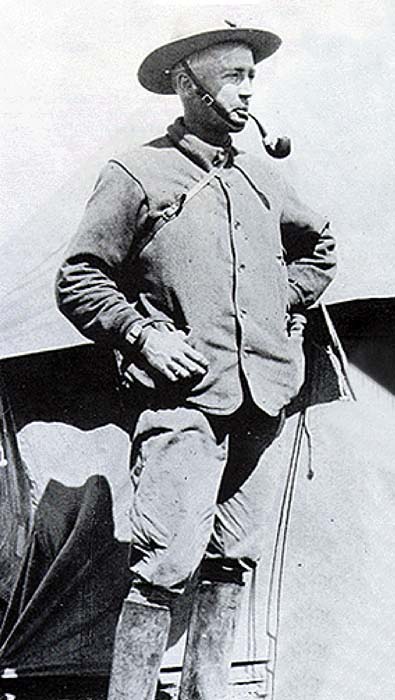
George S. Patton, Jr. The name brings shuddering images of the brutally tough, old school four-star general, one of America’s great command heroes of World War II. Yet, before all that, Patton proved his combat skill in a stand-up, man-on-men shootout in a most unlikely place against an unlikely foe. George Patton’s storied military career began in Mexico during the hunt for Pancho Villa in 1916.
Born November 11, 1885, in San Gabriel, California, George Smith Patton, Jr. followed in his ancestors’ footsteps, attending Virginia Military Academy and later graduated/commissioned from the U.S. Military Academy in 1909. After competing in the 1912 Olympics, where a judge’s horrendous error cost him a Gold Medal in the Pentathlon, Patton trained with the old “boots and saddles” cavalry at Fort Riley, Kansas, where he embraced the Colt Peacemaker, one of which became his ivory-handled trademark as America’s tough guy military icon. Soon, he would draw real blood with his Colt.
In 1910, Mexico was in a period of violent uncivil war. Francisco Madera, an influential idealist, ended the thirty-year reign of the dictator, Porfirio Diaz. Enter Jose Doroteo Arangp Arambula, far better known to the world as Francisco “Pancho” Villa, a cattle hustler, rustler, drover, butcher, murderer and damned good self-taught combat commander who had killed his first man at age 16. He formed his own private “army” in Northern Mexico and supported Madera. However, within three years, Madera was executed by his own top general, Victoriano Huerta, who quickly declared himself president and imposed a tyrannical police state.
Villa escaped the murderous clutches of Huerta, taking refuge in El Paso, Texas, where he reportedly met young Arnold Rothstein, soon to become a major Mafia leader, who arranged financing for armament purchases. After Madera’s death, Villa crossed back to Mexico with another private army to depose Huerta, in hopes of becoming Mexico’s next president. He had the editorial support of William Randolph Hearst’s powerful newspapers due to the media baron’s mega-holdings and investments in Mexico. However, Venustiano Carranza, who had the support of American President Woodrow Wilson, had troops with quiet American aid and Huerta fell in July 1914. Carranza became president, and Villa became embittered.
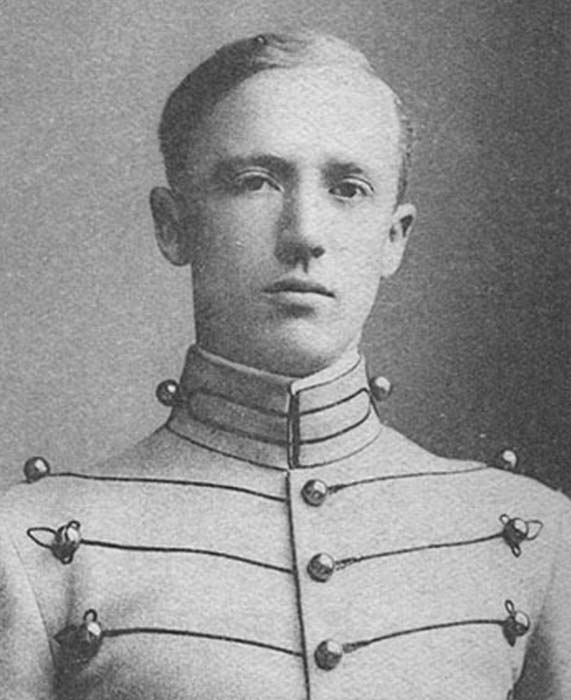
Disillusioned and finding himself and what was left of his army unemployed, Villa became a roving bandit gang along the border, irritating both Mexicans and Americans. Then, he did the unthinkable, leading his men boldly across that border and attacking the sleepy little town of Columbus, New Mexico on the morning of March 9, 1916.
Yelling “Viva Villa,” and “Muerte a los Americanos,” his men shot up the town, robbed, pillaged and set fire to many buildings. The small local detachment of the U.S. 13th Calvary may have been the only thing that saved Columbus from total annihilation. As the attack dust cleared, 39 soldiers, bandits and civilians littered the ground, with Villa fleeing back to Mexico…fast!
The United States was outraged, and the population demanded action. Back then, unlike today, American citizens got positive reaction decisions quickly. On March 15, 1916, on orders from President Wilson and despite Carranza’s protests, General John Pershing led the Punitive Expeditionary force over the Mexican border. Part of Pershing’s force was the 11th Calvary to which 2nd Lt. George S. Patton was assigned.
Bored with the inaction and constant training, young Lt. Patton craved excitement. When his unit was assigned routine border patrol, he took his case directly to Gen. Pershing to accompany the raiders chasing Villa. Patton sold Pershing on taking him as a replacement for one of his absent aides, a decision that would weave the legend of Patton’s tough guy personal valor and heroism.
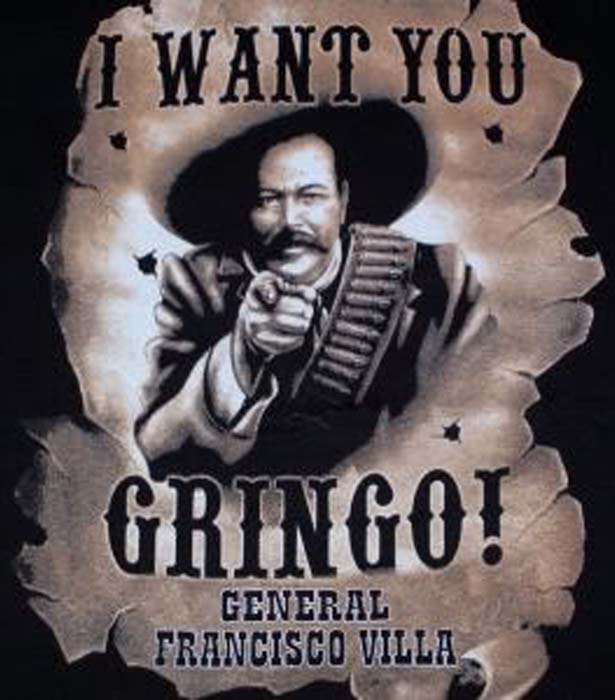
By May, deep into Northern Mexico with Pershing’s 6th Infantry Regiment, Patton was in charge of locating the head of Villa’s personal bodyguards, the Dorados. Capt. Julio Cardenas was thought to be hiding near the village of Rubio at Rancho San Miguelto. Patton did a quiet recon of the compound, memorizing every tactical detail.
Patton had traded cavalry horses for noisy Dodge Touring cars to make it look less like a recon patrol and more like a loud, brazen supply trip to the village. Many historians claim he was the first U.S. officer to use motor vehicles in a combat patrol mission. Thus, while purchasing supplies for his men, Patton was tipped by locals that Cardenas was at the ranch. Traveling with Patton in three cars were a corporal, six privates and a civilian interpreter. Patton wanted to approach the ranch with caution as he heard that Cardenas possibly had twenty men with him.
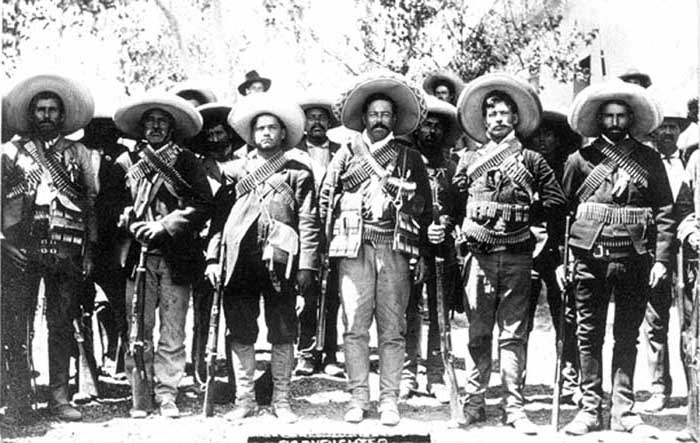
Allowing his men to surround the ranch to the southwest with two cars, Patton took the other car, the driver, the interpreter and a private to the northwest. After dropping Patton and the interpreter off, the driver and the private went to cover the north and west sides of the ranch. As Patton was walking onto the ranch, three men on horseback made a break for it. Having seen Patton, the men rode in the direction toward the southwest corner, where they ran into the blockade of soldiers. Thinking their odds would be better against the lone gringo on foot, the men turned and charged. But, the young lieutenant had a trusted ally: his Colt .45 Single Action Army revolver.
Colt had supplied the U.S. Calvary with that iconic revolver, aka the Peacemaker, since 1872. However, by 1916, they were no longer standard issue. The Calvary now carried the Colt .38 Model 1892 Double Action Army revolver. Not Patton. He not only continued to carry his old Colt Peacemaker with the 4 3/4-inch barrel, but his was custom made, a privilege not many young officers shared. His gun’s grip was ivory clad and along with his initials, an eagle was carved into the ivory by Colt’s own chief engraver, Cuno Helfricht.

For Patton’s first shootout he carried only that single Colt, but he also quickly learned a deadly lesson: from that day and from then on, he always carried two handguns. Those two guns became Patton’s Symbol, which he carried, literally, throughout his military career and into American history.
It was with this legendary six shooter that Patton entered the showdown with Villa’s men who were charging at him. Armed with Winchester and Mexican army issue Mauser rifles, plus Colt revolvers, the banditos opened fire from twenty yards out. Standing tall, firm and unfazed, Patton returned fire with his Peacemaker. As the Mexicans’ semi-aimed rounds rained down around him, Patton calmly shot one rider through the arm, the .45 Colt slug breaking it instantly. But still, the horseman rode on. Young Lt. Patton realized he needed to take down the horses first, then the armed riders.
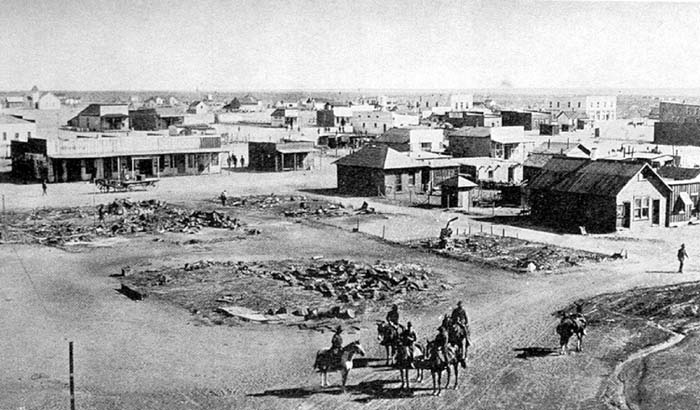
Bringing down the lead horse and its rider, Patton had emptied his Colt, so he took sparse brush cover to reload. The other two riders had passed Patton while firing blindly. Patton realized that he was in trouble, even as he calmly reloaded his Peacemaker. As the Mexicans turned to charge again, Patton aimed, dropped the one horse, which pinned its rider. Patton waited patiently until the rider freed himself from the cover of the dead animal, before firing the second shot, taking down the second Mexican. The third horseman turned his mount away to flee. By this time, two of Patton’s soldiers had reached their officer, and the three Americans took the rider off his horse, fatally.
The first man shot was not killed when his horse fell and tried to flee, broken arm and all. Patton shouted at him to HALT! Stopping, the Mexican raised his wounded arm as if to surrender, but before he could be taken into custody, he quickly drew his revolver and shot himself dead. Patton recognized the dead Mexican as Capt. Cardenas, Villa’s senior personal bodyguard, the man he’d been assigned to capture.
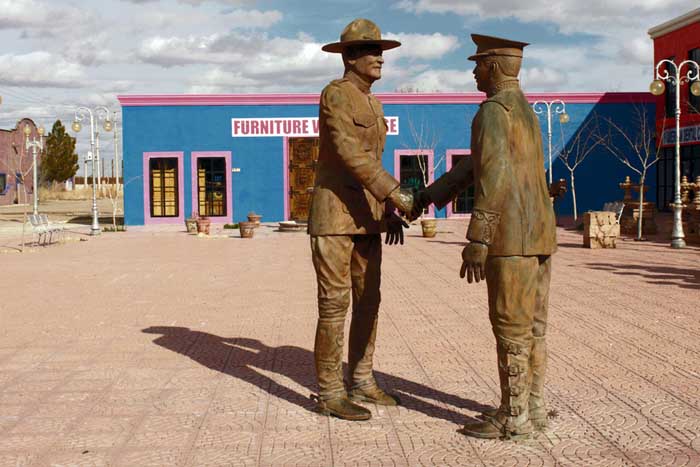
Needing to get out of that area as quickly as possible to escape vengeful wrath of Villa’s banditos or nearby villagers, Patton strapped one body to the hood of each of his touring cars and took off, headed North to Pershing’s HQ at Dublan. Arriving at base camp late in the afternoon, Patton learned that Pershing was in a staff meeting. Yet, anxious to show his general the very personal evidence of the successful patrol, Patton insisted that the general be pulled from his meeting. Angry at the interruption, then seeing the bodies ripened by the Mexican sun and the heat from the hoods of the touring cars, and knowing that one was a top Villa aide, Pershing quickly joined the enthusiasm and success of his young lieutenant. In fact, Pershing was so impressed with Patton’s exploit that he nicknamed him “Bandit.” That American journalists were at the HQ camp, including photographers, made the event a “headliner” in the U.S. for that week.
When the American public read/saw this news of Patton’s adventures, they hailed him as a national hero. In fact, Patton’s showy shootout was one of the few successful missions of the Punitive Expedition. And to punctuate both the event and his new nickname, Patton carved two notches into his Colt’s ivory grip.
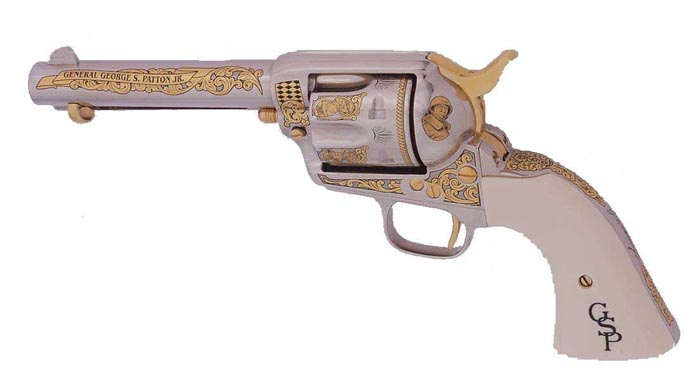
Overall, the Punitive Expedition proved fruitless. So, after ten months, Wilson pulled Pershing and his troops out of Mexico in January of 1917. It would be another six years before Villa was ambushed and killed by local rivals in Parral.
The Punitive Expedition was not a complete letdown. It warmed the American military for Wilson’s weak, reluctant entry into WWI, plus it solidified what George S. Patton always knew and felt in his heart, which was he was meant to be a military mastermind and fearless in the face of danger.

Despite his WWII reputation as a tough, lead from the front foul mouth, George Patton was also a very erudite and sophisticated officer who often flew his own C&C aircraft to staff meetings and recons. Four Star General George S Patton, Jr., died on 21 December, 1945 of severe spinal injuries suffered in an automobile wreck in Germany, though there is controversy as to whether the wreck was an accident or an assassination.
Best known for his heroic, personal leadership in World War II, it was Patton’s aggressive, brave and personal action in Mexico, with his famous Colt Peacemaker which started him on the fast track to legend.
| This article first appeared in Small Arms Review V16N3 (September 2012) |












